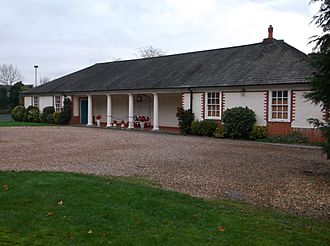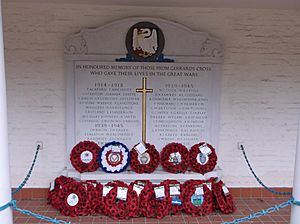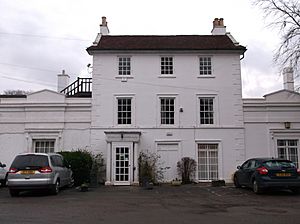Gerrards Cross Memorial Building facts for kids
Quick facts for kids Gerrards Cross Memorial Building |
|
|---|---|

The memorial building photographed in late 2015
|
|
| General information | |
| Type |
|
| Address | East Common |
| Town or city | Gerrards Cross, Buckinghamshire |
| Country | England |
| Coordinates | 51°35′01″N 0°33′06″W / 51.583576°N 0.551712°W |
| Technical details | |
| Material | Red brick |
| Designations | Grade II listed |
| Memorial | |
| Gerrards Cross Community Association | |
| For those from Gerrards Cross who gave their lives in the Great Wars | |
| Unveiled | 14 October 1922 |
| Designed by | Sir Edwin Lutyens |
| Commemorated | 35 |
|
IN HONOURED MEMORY OF THOSE FROM GERRARDS CROSS WHO GAVE THEIR LIVES IN THE GREAT WARS 1914–1918 1939–1945 THEIR NAME LIVETH FOR EVERMORE
|
|
The Gerrards Cross Memorial Building is a special place in the village of Gerrards Cross, England. It's both a community centre and a memorial for those who fought in the First World War. This building was designed by a famous British architect named Sir Edwin Lutyens.
Sir Edwin Lutyens is well-known for creating many war memorials, including the Cenotaph in London. What makes the Gerrards Cross Memorial Building unique is that it's the only war memorial he designed that also serves a practical purpose. It's not just a monument; it's a useful building for the community.
Why This Building Was Created
After the First World War ended, many towns across Britain wanted to remember the people who had died. Thousands of memorials were built. In Gerrards Cross, the local vicar, Reverend John Matthew Glubb, had a different idea.
He wanted a "living memorial." This meant a building that would be useful to the village and to the soldiers who returned from the war. He suggested turning the old stables of the vicarage (the vicar's house) into a community centre. Instead of just building a statue, the village decided to create a place where people could gather. They formed a group called the Gerrards Cross Community Association. Their goal was to create and manage a community centre that would also be a war memorial.
Designing the Memorial Building
Sir Edwin Lutyens was chosen to design this important building. He designed over 40 war memorials after the First World War. However, the Gerrards Cross building was the only one he made that had a practical use. Before the war, Lutyens was already famous for designing beautiful country houses. His design for the Cenotaph in London made him even more popular for war memorials.
The Gerrards Cross Memorial Building was based on the old 18th-century vicarage stables. It is set back from the road and partly hidden by hedges. The building is mostly made of red brick, but most of it is painted white. It has a slate roof and a large entrance area called a portico.
The roof of the portico is held up by four white stone columns. Inside this portico, there is a stone plaque. This plaque lists the names of the men from the village who died in the First World War.
The inside of the building has a main hall in the middle. There are also "wings" on the sides, making the building look like a U-shape. You can get into these side wings from outside through doors at each end of the portico. From the front, the building looks like it has only one floor. But at the back, the roof is shorter, showing an attic floor above the main hall.
Lutyens had originally planned for another portico at the back to make the hall even bigger, but this was not built. The whole project cost about £3,500 in 1922. This money was raised by people donating to the cause. The building was officially opened on 14 October 1922. A special person named Charles Wynn-Carington, 1st Marquess of Lincolnshire, who was the Lord Lieutenant of Buckinghamshire, opened it.
History After the Wars
In 1947, the memorial plaque on the front of the building was replaced. The new plaque was made by a sculptor named Edmund Ware. It has two columns of names, separated by a sword design. Above the names is the old coat of arms for Buckinghamshire.
In the same year, the Gerrards Cross Community Association was officially created. This group helps the village community and is in charge of the memorial building. The old vicarage house itself, which is next to the memorial building, was bought after the Second World War. It was turned into the Gerrards Cross Memorial Centre. This new centre became a memorial for the Second World War.
In 2015, Historic England announced that Sir Edwin Lutyens' war memorials were very important national treasures. Because of this, the Gerrards Cross Memorial Building was given a special status called "grade II listed building." This means it is a historically important building that needs to be protected. Before this, it was the only one of Lutyens' 44 memorials in England that didn't have this protection. The nearby Memorial Centre also has a grade II listed building status since 1985.
Today, the memorial building is still actively used by the community. It is also the main office for the local branch of the Royal British Legion, a charity that helps members of the armed forces and their families.



